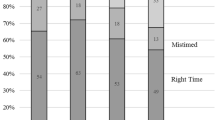Abstract
Because birth intendedness is typically measured retrospectively, researchers have raised concerns about the accuracy of reporting. Our objective was to assess the stability of intendedness reports for women asked about the same birth at different times. We used data from Wave III (2001–2002; ages 18–24) and Wave IV (2007–2008; ages 25–32) of the National Longitudinal Study of Adolescent Health, a nationally representative school-based sample first surveyed in 1995. For the 1,463 women who reported a first birth by Wave III that could be matched with the same birth reported at Wave IV, we examined whether intendedness was characterized consistently at both waves. We constructed descriptive measures of consistency in reporting and estimated logistic regression models predicting changes in reports. Nearly four-fifths of young mothers did not change their reports across waves, with about 60 % reporting their first birth as unintended. However, 22 % of women changed the intendedness categorization of their first birth between surveys. Women who initially reported the birth as intended were more likely to recategorize the birth as unintended than vice versa. With the exception of race and employment, most socioeconomic and demographic characteristics were unrelated to the likelihood of recategorizing first birth intendedness in multivariate models. Most reports of birth intentions are stable, but there is a nontrivial degree of inconsistency. Cross-sectional reports may either under- or overestimate the prevalence of unintended fertility. It remains to be seen whether, and how, consistency of reports is linked to maternal and child health and well-being.
Similar content being viewed by others
References
Barber, J. S., & East, P. L. (2011). Children’s experiences after the unintended birth of a sibling. Demography, 48, 101–125.
Logan, C. E., Holcomb, E., Manlove, J., & Ryan, S. (2007). The consequences of unintended childbearing: A white paper prepared by child trends for the national campaign to prevent teen and unplanned pregnancy. Washington, D.C.: Child Trends.
Hellerstadt, W. L., Pirie, P. L., Lando, H. A., et al. (1998). Differences in preconceptional and prenatal behaviors in women with intended and unintended pregnancies. American Journal of Public Health, 88, 663–666.
U.S. Department of Health and Human Services (2013). Proposed healthy people 2020 objectives, family planning. http://www.healthypeople.gov/2020/topicsobjectives2020/overview.aspx?topicid=13 Last updated April 24, 2013. Accessed 4 June 2013.
Mosher, W. D., Jones, J., & Abma, J. C. (2012). Intended and unintended births in the United States: 1982–2010. National health statistics reports; no. 55. Washington, DC: National Center for Health Statistics.
Sable, M. R. (1999). Forum: Pregnancy intentions may not be a useful measure or research on maternal and child health outcomes. Family Planning Perspectives, 31, 249–250.
Santelli, J. S., Rochat, R., Hatfield-Timajchy, K., et al. (2003). The measurement and meaning of unintended pregnancy. Perspectives Sex Repro H, 35, 94–101.
Trussell, J., Vaughan, B., & Stanford, J. (1999). Are all contraceptive failures unintended pregnancies? Evidence from the 1995 national survey of family growth. Family Planning Perspectives, 31(246–247), 260.
Greenhoot, A. F. (2011). Retrospective methods in developmental science. In B. Laursen, T. D. Little, & N. A. Card (Eds.), Handbook of developmental research methods New York (pp. 196–210). NY: The Guilford Press.
Goldberg, S. K., Haydon, A.A., Herring, A.H., Halpbern, C. T. (Forthcoming). Longitudinal consistency in self-reported age of first vaginal intercourse among young adults. Journal of Sex Research.
Schroder, K. E. E., Carey, M. P., & Vanable, P. A. (2003). Methodological challenges in research on sexual risk behavior: II. Accuracy of self-reports. Annals of Behavioral Medicine, 26, 104–123.
Klerman, L. K. (2000). The intendedness of pregnancy: A concept in transition. Maternal and Child Health Journal, 4, 155–162.
Westoff, C., & Ryder, N. B. (1977). The contraceptive revolution. Princeton, NJ: Princeton University Press.
Murphy, N. A., & Isaacowitz, D. M. (2008). Preferences for emotional information in older and younger adults: A meta-analysis of memory and attention tasks. Psychology and Aging, 23, 263–286.
Joyce, T. J., Kaestner, R., & Korenman, S. (2000). The stability of pregnancy intentions and pregnancy-related behavior. Maternal and Child Health Journal, 4, 171–179.
Kendall, C., Afable-Munsuz, A., Speizer, I., et al. (2005). Understanding pregnancy in a population of inner-city women in New Orleans—results of qualitative research. Social Science and Medicine, 60, 297–311.
Joyner, K., Peters, H. E., Hynes, K., Sikora, A., Rubenstein, J., & Rendall, M. S. (2012). The quality of male fertility fata in major U.S. surveys”. Demography, 49, 101–124.
Jones, R. K., & Kost, K. (2007). Underreporting of induced and spontaneous abortion in the United States: An analysis of the 2002 national survey of family growth. Studies in Family Planning, 38, 187–197.
Santelli, J. S., Lindberg, L. D., Orr, M. G., Finer, L. B., & Speizer, I. (2009). Toward a multidimensional measure of pregnancy intentions: Evidence from the United States. Studies in Family Planning, 40, 87–100.
Acknowledgments
An earlier version of this paper was presented at the 2013 annual meeting of the Population Association of America, New Orleans, LA. This research was supported in part by the Center for Family and Demographic Research, Bowling Green State University, which has core funding from the Eunice Kennedy Shriver National Institute of Child Health and Human Development (R24HD050959-09). This research uses data from Add Health, a program project directed by Kathleen Mullan Harris and designed by J. Richard Udry, Peter S. Bearman, and Kathleen Mullan Harris at the University of North Carolina at Chapel Hill, and funded by grant P01-HD31921 from the Eunice Kennedy Shriver National Institute of Child Health and Human Development, with cooperative funding from 23 other federal agencies and foundations. Special acknowledgment is due Ronald R. Rindfuss and Barbara Entwisle for assistance in the original design. Information on how to obtain the Add Health data files is available on the Add Health website (http://www.cpc.unc.edu/addhealth). No direct support was received from grant P01-HD31921 for this analysis.
Author information
Authors and Affiliations
Corresponding author
Rights and permissions
About this article
Cite this article
Guzzo, K.B., Hayford, S.R. Revisiting Retrospective Reporting of First-Birth Intendedness. Matern Child Health J 18, 2141–2147 (2014). https://doi.org/10.1007/s10995-014-1462-7
Published:
Issue Date:
DOI: https://doi.org/10.1007/s10995-014-1462-7




